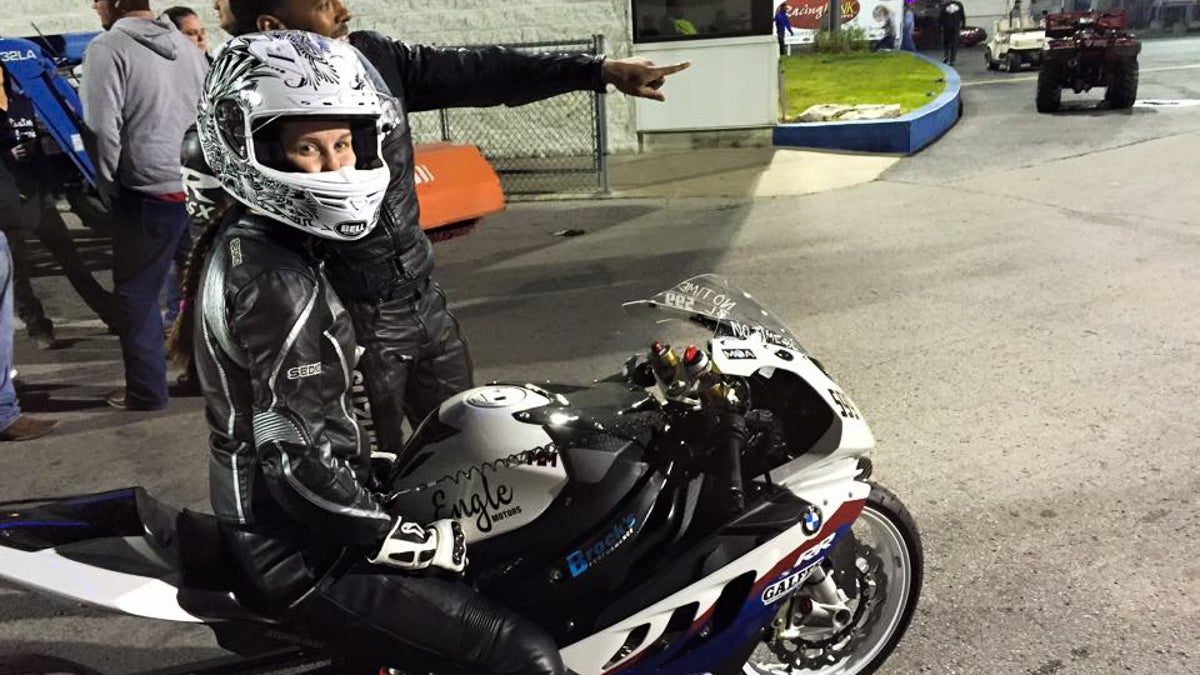Road to recovery: a motorcycle racer works hard to get back on the track
Listen
Elyse McKinnon's rise in motorcycle drag race nearly came to a halt after a tragic accident in 2015. (Courtesy McKinnon Motorsports)
In June 2015, a devastating crash put Elyse McKinnon on a year-long quest to get back to racing.
For anyone who knows Elyse McKinnon, it’s hard to imagine her not tearing down a racetrack on a motorcycle. But life without racing is just what the 30 year old had to consider after a tragic crash in the summer of 2015 that left her with a broken back.
McKinnon and her husband, Chris McKinnon, of Lawrence, Kansas have been avid motorcyclists since moving to the Midwest from Florida shortly after Elyse graduated from college.
Elyse says her competitive drive prompted her transition from weekend rider to competitive drag racer.
“I’ve always been pretty competitive,” McKinnon says. “When I’m in a competition, it just fuels something in me that I need to beat that other person. So I need to go as fast as I can to be able to win that race.”
During the past few years, they’ve traveled the region as Team McKinnon—Elyse as racer and Chris as mechanic. Elyse is one of relatively few women in the competitive drag racing circuit.
McKinnon remembers little of the actual race that took place on June 26, 2015 at the I-29 Dragway in Pacific Junction, Iowa. She says it started like any other race: she was randomly paired up with another racer, burned out her tires and approached the starting line to wait for the sequence of light that signaled the start of the race.
After that, her memory is a blur.
“I just remember getting woken up again,” McKinnon says.
The quarter-mile “sprints” typically only last around 8 seconds, and the turnover of racers happens so fast that no one usually watches the end of the track. And that summer evening in June of last year, no one saw McKinnon’s crash.
“We’re not 100 percent sure whether it was a mechanical failure or something else,” McKinnon says. “It seems that it may have been brake related.”
After hearing the announcement “rider down” over the dragway’s PA system, Chris and a friend rushed to the end of the track to find Elyse had crashed into the tire wall designed to stop out-of-control race cars.
She was taken by helicopter to Nebraska Medical Center, where doctors worked to repair a host of injuries, including a broken back. The next day, the surgeon performed a spinal fusion, connecting broken pieces of vertebrae with titanium rods.
“Thankfully, I was very blessed that I didn’t have any spinal cord injury,” McKinnon says, recalling the diagnosis she received from the hospital’s back surgeon. “But the lack of stability, with the fact that that bone was broken all the way through, was why he had the urgency to get the surgery done.”
The operation helped to protect her spinal column during the critical early phase shortly after the accident, but the rods will also likely remain in place for the rest of her life.
For several months following the surgery, McKinnon worked with physical therapists in painstaking baby steps to recover her health.
“They would each give me, ‘OK, here’s your goal of things to do,'” McKinnon says. “And I didn’t have anything else to do all day, especially at the beginning, so that’s what I was going to work on.”
McKinnon describes herself as an optimist, but she says the challenge of recovery could sometimes feel overwhelming.
“I had a couple of days here and there that I got discouraged, but it was always, ‘OK, let’s start the next day fresh. What do I need to get done today?” McKinnon recalls.
Much of the physical therapy aimed to help her return to walking and moving normally, but the future of her riding also weighed heavily on Elyse’s mind.
“It was a really big question, something that we talked a lot about, and I thought a lot about: whether I would race again, or even whether or not I would ride a motorcycle again,” McKinnon says. “But after a lot of thought and consideration and prayer about it, too, I decided I couldn’t even imagine my life without doing it again – either driving a motorcycle or racing.”
About a year after the accident, in June of 2016, Elyse and Chris took a motorcycle to their hometown track outside of Lawrence for a test run.
During her first test run, Elyse – for once – was determined to take it slow.
“I just needed to make a pass down the track,” she says. “It didn’t have to be as fast as possible, but I just needed to do it.”
After an easy first ride, Elyse felt her old confidence quickly start to return.
“The second pass, I felt even more comfortable to get a little more aggressive with it,” McKinnon says. “So I just kind of stepped up from that first pass, and that’s what I’ve been able to do ever since, is just keep increasing my game to get faster and faster.”
Elyse announced her return to racing shortly thereafter, and she quickly proved the accident had little lasting effect on the talent or competitive drive that fans and fellow racers had known.
“Early this season, I was able to set a new personal best on one of our bike that we own,” she says. “That was pretty exciting: to not only just be back in the sport but be competitive back in the sport.”
WHYY is your source for fact-based, in-depth journalism and information. As a nonprofit organization, we rely on financial support from readers like you. Please give today.



